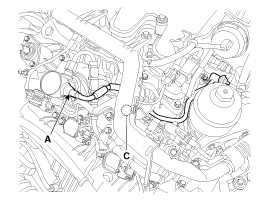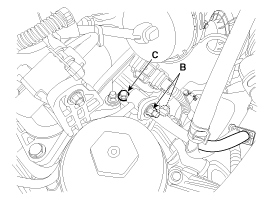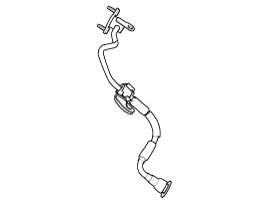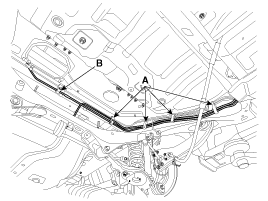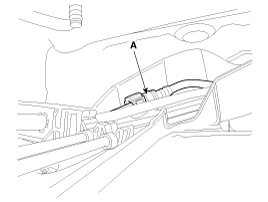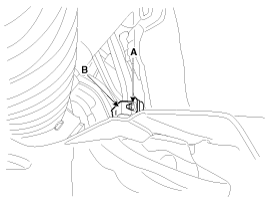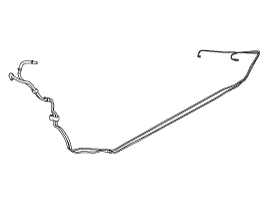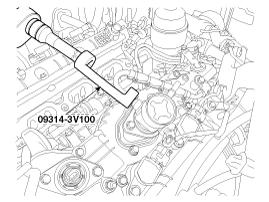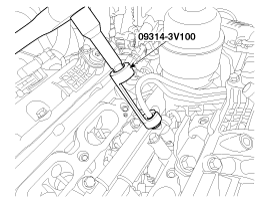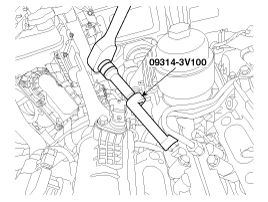Kia Cadenza: Fuel Delivery System / Fuel Line Repair procedures
Kia Cadenza YG 2016-2025 Service Manual / Engine Control / Fuel System / Fuel Delivery System / Fuel Line Repair procedures
| Removal |
In case of removing the high pressure fuel pump, high
pressure fuel pipe, delivery pipe, and injector, there may be injury
caused by leakage of the high pressure fuel. So don’t do any repair
work right after engine stops. |
| [Low pressure fuel line] |
| 1. |
Turn the ignition switch OFF, and then remove battery (-) cable. |
| 2. |
Release the residual pressure in fuel line.
(Refer to the Fuel Delivery System - Repair Procedures - "Release Residual Pressure in Fuel Line"). |
| 3. |
Disconnect the low pressure fuel quick-connector (A) and remove the installation nuts (B) and bolts (C).
|
| 4. |
Disconnect the vapor hose (A) which is connected from the PCSV.
|
| 5. |
Remove the fuel tank.
(Refer to Fuel Delivery System - " Fuel Tank") |
| 6. |
Disconnect the vapor tube quick-connector (A).
|
| 7. |
Open the vapor tube and low fuel line fixing clip (A) to using driver. |
| 8. |
Remove the installation bolt, and then release the fuel line fixing clip (B).
|
| 9. |
Disconnect the fuel & brake line protect (A) from the fixing clip (B).
|
| 10. |
Disconnect the fuel line quick-connecter (A).
|
| 11. |
Remove the installation nut (A), and then open the fuel line fixing clip(B) to engine room low.
|
| 12. |
Remove the fuel line.
|
| [High pressure fuel line] |
| 1. |
Turn the ignition switch OFF, and then remove battery (-) cable. |
| 2. |
Release the residual pressure in fuel line.
(Refer to the Fuel Delivery System - Repair Procedures - "Release Residual Pressure in Fuel Line"). |
| 3. |
Remove the intake manifold.
(Refer to Engine Mechanical System - "Intake Manifold") |
| 4. |
Remove the high pressure fuel pipe.
(Refer to Fuel Delivery System "High Pressure Fuel Pump")
|
| Installation |
|
|
| 1. |
Install in the reverse order of removal.
|
 Fuel Pressure Sensor (FPS) Specifications
Fuel Pressure Sensor (FPS) Specifications
Specification
Pressure [KPa (kgf/cm², psi)]Output Voltage (V)50 (0.51, 7.3)0.3600 (6.12, 87.0)2.51100 (11.2, 159.5)4.51200 (12.2, 174.0)5
...
 Filler-Neck Assembly Repair procedures
Filler-Neck Assembly Repair procedures
Removal
1.
Open the fuel filler door and then remove the filler-neck installation screw (A).
2.
Lift the vehicle.
3.
Remove the rear-LH wheel, tire, and the inner wheel house.
4.
Disco ...
Other information:
Kia Cadenza YG 2016-2025 Owners Manual: To convert to cruise control mode
The driver may choose to only use the cruise control mode (speed control function) by doing as follows: 1. Turn Smart Cruise Control on (the cruise indicator light will be on but the system will not be activated). 2. Push the distance to distance switch for more than 2 seconds. 3. C ...
Kia Cadenza YG 2016-2025 Service Manual: AVN Head Unit Components and Components Location
Components AVN (A/V & Navigation) Head Unit Connector Connector Pin Information No.Connector AConnector BConnector C1-MM CAN high-2Back view camera video--3Back view camera video ground--4Back view camera power groundSteer keyRS422 ground5SPDIF ground-RS422 Tx (+)6SPDIF (+)-RS422 Tx (-) ...
Copyright © www.kcadenzavg.com 2017-2025



